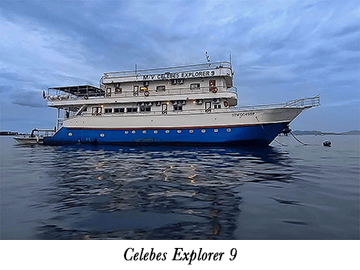Celebes Explorer 9, Sipadan Island, MalaysiaContents of this Issue: Tobago Dive Experience, Trinidad and Tobago No Piece of Dive Gear is Worth Your Life Celebes Explorer 9, Sipadan Island, Malaysia When Lights Attract Unwanted Attention Use a Travel Agent or Book it Yourself? Part I Are Third World Scuba Tanks Safe? Protecting Our Oceans and Dive Sites The Genetic Adaptation of the Sea Women Editorial Office: Ben Davison Publisher and Editor Undercurrent 3020 Bridgeway, Suite 102 Sausalito, CA 94965 the only guaranteed way to dive Sipadan from the June, 2025 issue of Undercurrent
Subscriber Content Preview Dear Fellow Diver, It was our last day of diving Sipadan, and I requested to see a school of big bumphead parrotfish known to forage in the shallows. Soon after we began our dive, five large bumpheads scurried past. I put my fist to my head, signaling to my guide, Ummi, but we could not catch up with them. It was still a fine dive, with the reef tops encrusted in colorful hard corals where small tropical fish dodged in and out, and a large African pompano made a couple of passes. But I was disappointed to be going home without achieving my bumphead photography goals. As I handed up my camera to the head divemaster, Tom, he shouted, "Wow, the bumpheads are right behind you!" He returned my camera, and I went after them to, at last, photograph six big bumpheads.
Today, there are only two ways to dive Sipadan: by day boats from the mainland or resorts on Mabul or Kapalai islands or from the liveaboard Celebes Explorer 9. The Marine Park permits only 268 divers per day, but the demand from resorts is far greater, so some vacationing divers miss out. To be certain I would dive Sipadan, I booked seven days on the Celebes Explorer, which guarantees two morning Sipadan dives and two afternoon dives off Kapalai or Mabul, where the boat anchors at night. After landing in Kota Kinabalu and clearing immigration and customs, carrying a bottle of duty-free Scotch that I had purchased in South Korea, we flew to the small Tawau Airport, where customs demanded that I pay duty, about half of what I had paid for the bottle. They had a crazy formula that somehow calculated the cost of the liquor, the alcohol volume, the bottle size, and, I believe, the thickness of my wallet. My Irish heritage wouldn't let good whiskey go down the drain, so I went to a nearby ATM, paid the ransom, wondering how many agents would get a piece of it, and then grabbed a cab to the Celebes' home port.... Subscribers: Read the full article here ; |

I want to get all the stories! Tell me how I can become an Undercurrent Online Member and get online access to all the articles of Undercurrent as well as thousands of first hand reports on dive operations world-wide
| Home | Online Members Area | My Account |
Login
|
Join
|
| Travel Index |
Dive Resort & Liveaboard Reviews
|
Featured Reports
|
Recent
Issues
|
Back Issues
|
|
Dive Gear
Index
|
Health/Safety Index
|
Environment & Misc.
Index
|
Seasonal Planner
|
Blogs
|
Free Articles
|
Book Picks
|
News
|
|
Special Offers
|
RSS
|
FAQ
|
About Us
|
Contact Us
|
Links
|
3020 Bridgeway, Ste 102, Sausalito, Ca 94965
All rights reserved.

 Jacques Cousteau "discovered" Sipadan Island, which is off the coast of Borneo, in 1988, and called it "an untouched piece of art." Quickly, it became the go-to dive destination, with scads of fish and turtles and even a cave where turtles went to die. Divers flocked to the island's primitive little resorts, but it lost some luster when, in 2000, Abu Sayyaf terrorists kidnapped eleven Malaysian resort workers and 10 foreign divers at dinner. They took them to Sulu in the Philippines and held them for ransom (see the sidebar). In 2004, Malaysia shut down the resorts and designated Sipadan a marine park.
Jacques Cousteau "discovered" Sipadan Island, which is off the coast of Borneo, in 1988, and called it "an untouched piece of art." Quickly, it became the go-to dive destination, with scads of fish and turtles and even a cave where turtles went to die. Divers flocked to the island's primitive little resorts, but it lost some luster when, in 2000, Abu Sayyaf terrorists kidnapped eleven Malaysian resort workers and 10 foreign divers at dinner. They took them to Sulu in the Philippines and held them for ransom (see the sidebar). In 2004, Malaysia shut down the resorts and designated Sipadan a marine park.